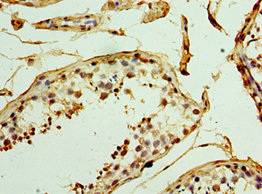UCP1 antibody
GTX112784
ApplicationsWestern Blot, ImmunoHistoChemistry, ImmunoHistoChemistry Paraffin
Product group Antibodies
TargetUCP1
Overview
- SupplierGeneTex
- Product NameUCP1 antibody
- Delivery Days Customer9
- Application Supplier NoteWB: 1:500-1:3000. IHC-P: 1:100-1:1000. *Optimal dilutions/concentrations should be determined by the researcher.Not tested in other applications.
- ApplicationsWestern Blot, ImmunoHistoChemistry, ImmunoHistoChemistry Paraffin
- CertificationResearch Use Only
- ClonalityPolyclonal
- Concentration0.34 mg/ml
- ConjugateUnconjugated
- Gene ID7350
- Target nameUCP1
- Target descriptionuncoupling protein 1
- Target synonymsSLC25A7, UCP, mitochondrial brown fat uncoupling protein 1, solute carrier family 25 member 7, thermogenin, uncoupling protein 1 (mitochondrial, proton carrier)
- HostRabbit
- IsotypeIgG
- Protein IDP25874
- Protein NameMitochondrial brown fat uncoupling protein 1
- Scientific DescriptionMitochondrial uncoupling proteins (UCP) are members of the family of mitochondrial anion carrier proteins (MACP). UCPs separate oxidative phosphorylation from ATP synthesis with energy dissipated as heat, also referred to as the mitochondrial proton leak. UCPs facilitate the transfer of anions from the inner to the outer mitochondrial membrane and the return transfer of protons from the outer to the inner mitochondrial membrane. They also reduce the mitochondrial membrane potential in mammalian cells. Tissue specificity occurs for the different UCPs and the exact methods of how UCPs transfer H+/OH- are not known. UCPs contain the three homologous protein domains of MACPs. This gene is expressed only in brown adipose tissue, a specialized tissue which functions to produce heat. [provided by RefSeq]
- Storage Instruction-20°C or -80°C,2°C to 8°C
- UNSPSC12352203
References
- Glycosaminoglycan dermatan sulfate supplementation decreases diet-induced obesity and metabolic dysfunction in mice.Read more
- Transdermal Delivery of Succinate Accelerates Energy Dissipation of Brown Adipocytes to Reduce Remote Fat Accumulation.Read more
- Daisaikoto improves fatty liver and obesity in melanocortin-4 receptor gene-deficient mice via the activation of brown adipose tissue. Morita S et al., 2022 Jun 16, Sci RepRead more
- Evaluation of Browning Markers in Subcutaneous Adipose Tissue of Newly Diagnosed Gastrointestinal Cancer Patients with and without Cachexia. Molfino A et al., 2022 Apr 12, Cancers (Basel)Read more
- Protective Effects of Individual and Combined Low Dose Beta-Carotene and Metformin Treatments against High-Fat Diet-Induced Responses in Mice. Stojnic B et al., 2021 Oct 14, NutrientsRead more
- N-butylidenephthalide ameliorates high-fat diet-induced obesity in mice and promotes browning through adrenergic response/AMPK activation in mouse beige adipocytes. Lu KY et al., 2021 Dec, Biochim Biophys Acta Mol Cell Biol LipidsRead more
- 3-N-butylphthalide protects against high-fat-diet-induced obesity in C57BL/6 mice and increases metabolism in lipid-accumulating cells. Lu KY et al., 2021 Jul, Biomed PharmacotherRead more
- High-Fat Diet-Induced Adipose Tissue and Liver Inflammation and Steatosis in Mice Are Reduced by Inhibiting Sialidases. Pilling D et al., 2021 Jan, Am J PatholRead more
- Serum Amyloid P and a Dendritic Cell-Specific Intercellular Adhesion Molecule-3-Grabbing Nonintegrin Ligand Inhibit High-Fat Diet-Induced Adipose Tissue and Liver Inflammation and Steatosis in Mice. Pilling D et al., 2019 Dec, Am J PatholRead more
- Identification of functional lipid metabolism biomarkers of brown adipose tissue aging. Gohlke S et al., 2019 Jun, Mol MetabRead more



